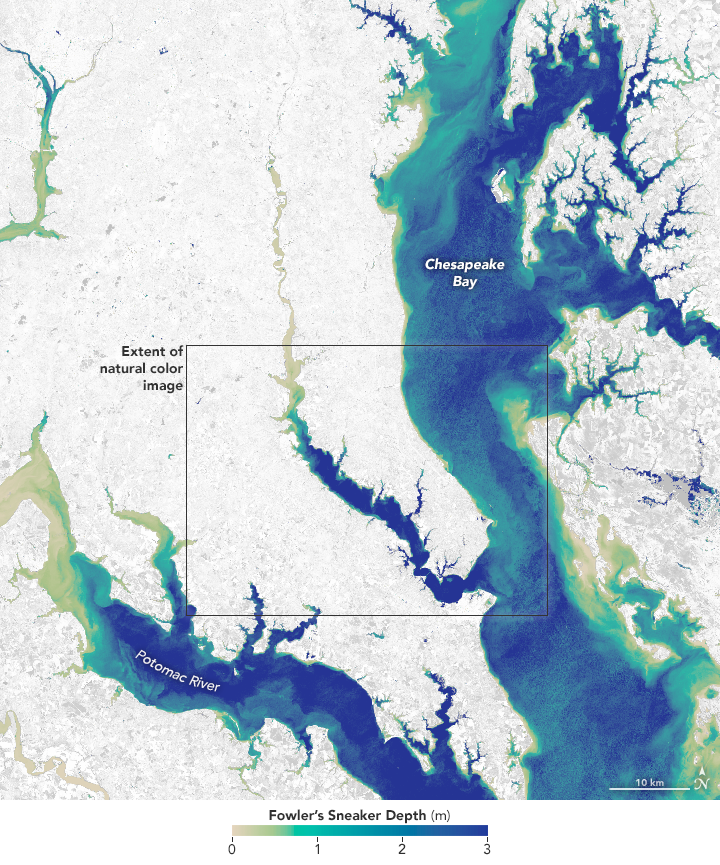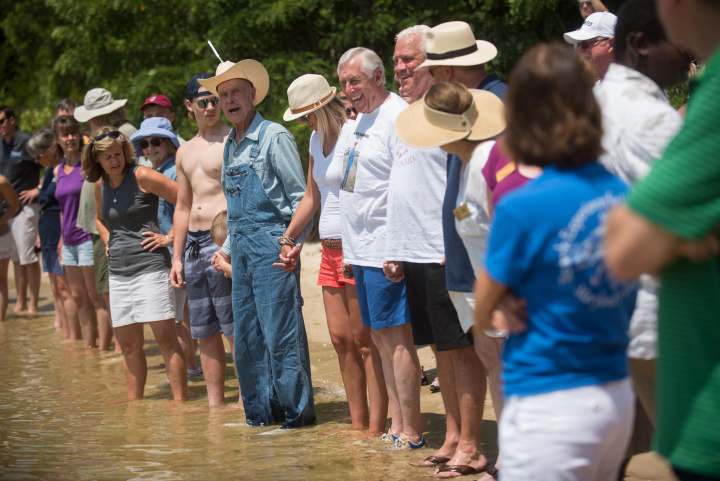


Wearing white sneakers, a cowboy hat, and overalls, Bernie Fowler walks into Maryland’s Patuxent River every June to see how deep he can wade in and still see the tops of his shoes. As a young man, he could see his feet on the river bottom as he stood in chest-deep water to net blue crabs. Now in his nineties, he ventures into the river to assess the water clarity. Fowler has been collecting this data point for 29 years, calling it “sneaker depth.”
“When you talk to people about the chemistry of the river with scientific words like eutrophication, it goes in one ear and out the other,” said Fowler. “If you put on white sneakers and wade out in the river until you can’t see your feet, that gives you a pretty good understanding of what’s going on.”
While scientists can make precise measurements of water clarity from satellite data, the calculations can be complex and hard to explain to people outside of oceanography. So some NASA scientists have adopted Fowler’s sneaker idea to communicate measurements of water clarity, enabling the observations to be shared easily with local governments, resource managers, or anyone else who might be interested.
While scientists in the ocean ecology lab at NASA’s Goddard Space Flight Center tend to focus on accuracy and precise measurement, oceanographer Lachlan McKinna noted that “we sometimes need better ways to communicate with the general public.” McKinna and colleagues call their new algorithm “Fowler’s Sneaker Depth.” The new measurement is the depth of water, in meters, at which a person can no longer see their white shoes.
The natural-color image at the top of this page shows the Patuxent River watershed and was acquired on April 13, 2016, by the Operational Land Imager (OLI) on the Landsat 8 satellite. The second image depicts the same scene after processing with the Fowler Sneaker Depth algorithm. Details of the method were published in the April 2017 issue of Optics Express.
A retired state senator, Fowler has been using “sneaker depth” as a way to communicate local changes in water clarity to his neighbors and community. Water clarity is vital because sunlight must be able to reach deep beyond the surface to help underwater plants grow and to maintain a healthy ecosystem. On June 11, 2017, Fowler and members of the local community will wade into the Patuxent River at Jefferson Patterson Park and make sneaker depth measurements for the thirtieth consecutive year.
Throughout the world, coastal waters have become murky due to an excess of suspended sediments (such as from eroded soil) or abnormally high levels of phytoplankton, particularly algae. While these effects occur naturally, they can be exacerbated by human activity within a watershed, such as land clearing, urban development, and the release of under-treated sewage. Poor water clarity can affect human and animal health, fishing, and aquaculture.

The sneaker depth algorithm was initially developed as part of a summer internship project by Ben Crooke, a 17-year-old Maryland high school student who spent part of his summer at NASA Goddard analyzing Fowler’s data and satellite imagery in order to understand local trends in water clarity. Crooke and the team examined data from the Moderate Resolution Imaging Spectroradiometer (MODIS) on NASA’s Aqua satellite, which measures the different wavelengths of light reflected by Earth’s land and water surfaces. They specifically looked at the amount of red light reflected by floating particles and sediments that can make water appear murky. The team then developed a mathematical model to relate the amount of reflected red light to the sneaker depth measured by Fowler in the Patuxent River between 2002 to 2016.
Once the method was established, the team observed how water quality varies with the seasons in the Patuxent, as observed by Aqua MODIS and Landsat. Fowler’s Sneaker Depth was greatest (the best visibility) in winter because river flow is minimal, there is less sediment flowing off the land, and environmental conditions are less favorable for phytoplankton growth. The late spring and early summer tended to have the lowest sneaker depth (least visibility).
Although “sneaker depth” was primarily designed as a communication tool, the concept is actually similar to the use of Secchi disks by oceanographers. Scientists lower a plain, white disk (one foot in diameter) into the water and record the depth at which it disappears from sight. The measurements are useful for marine scientists who want to know the depth that light is reaching into the water column.
The study showed potential influences on Patuxent River water clarity. In recent years, improved watershed management has reduced the impacts of activities that can pollute the river, such as land clearing, sewage treatment, agriculture, and urban development. Yet summer phytoplankton blooms still continue in the lower Patuxent River estuary, suggesting that some of the nutrients that promote blooms are coming into the river from the Chesapeake Bay.
NASA Earth Observatory images by Joshua Stevens, using Landsat data from the U.S. Geological Survey and Fowler's Sneaker Depth data courtesy of Lachlan McKinna, NASA GSFC. Photo courtesy of the Chesapeake Bay Program under a Creative Commons license. Story by Kasha Patel, NASA Goddard Space Flight Center, adapted by Mike Carlowicz.